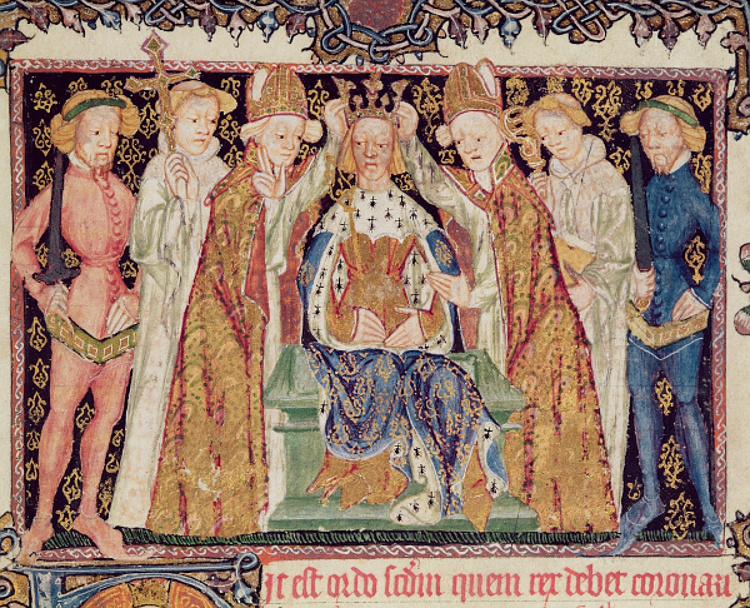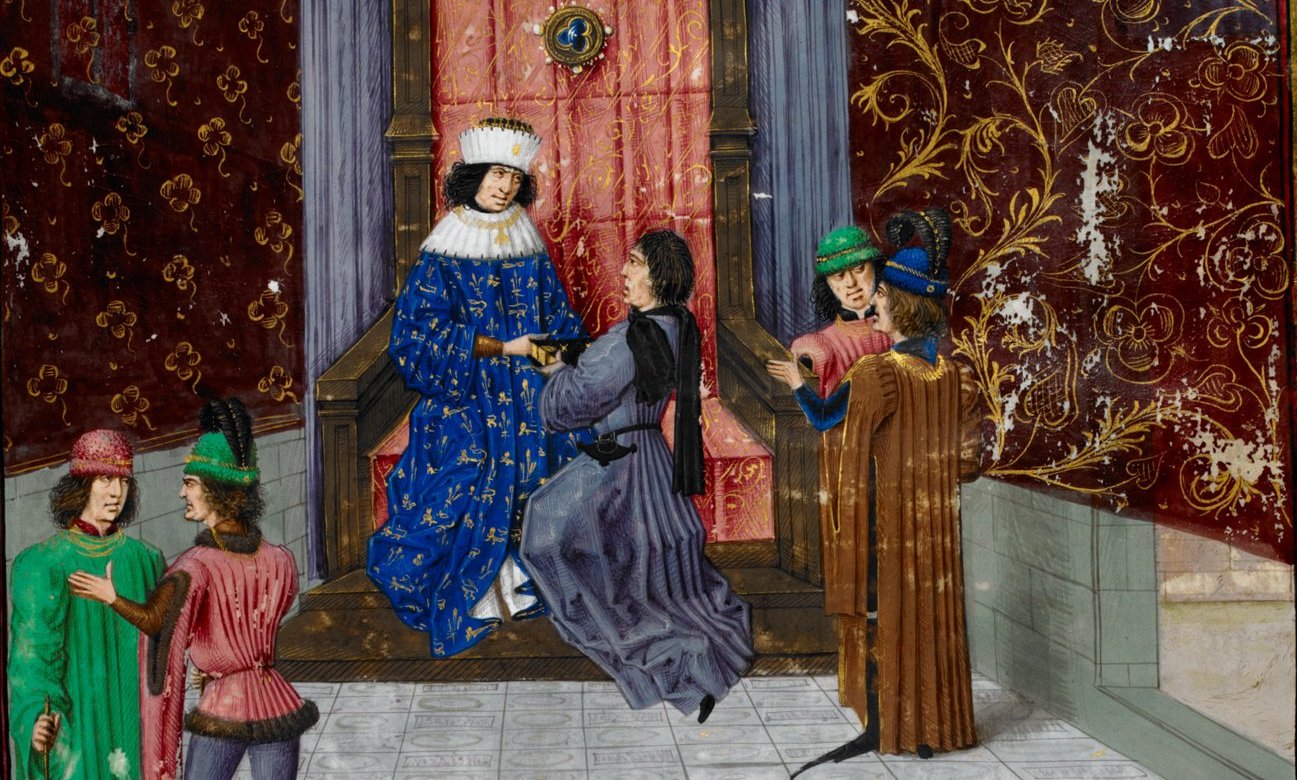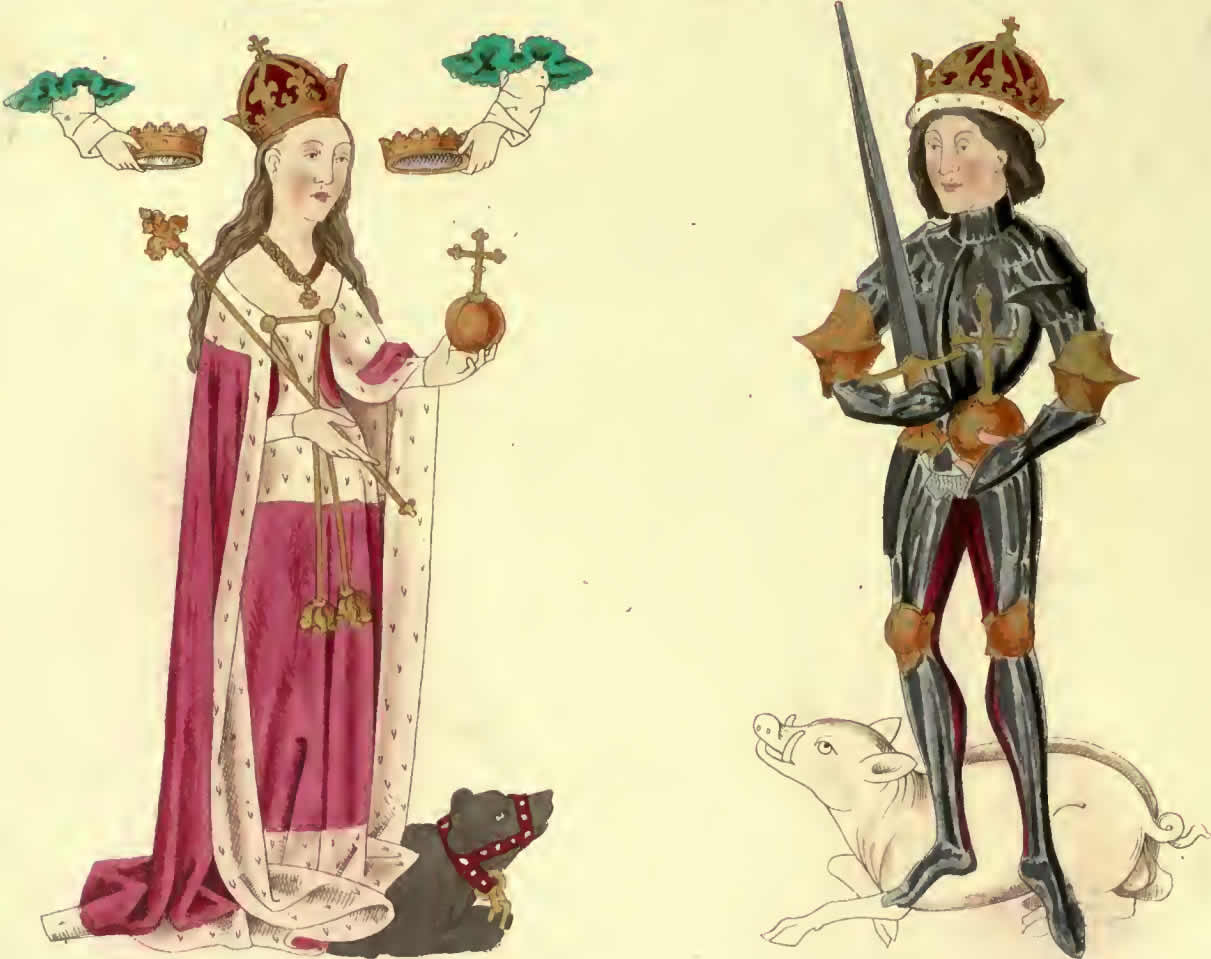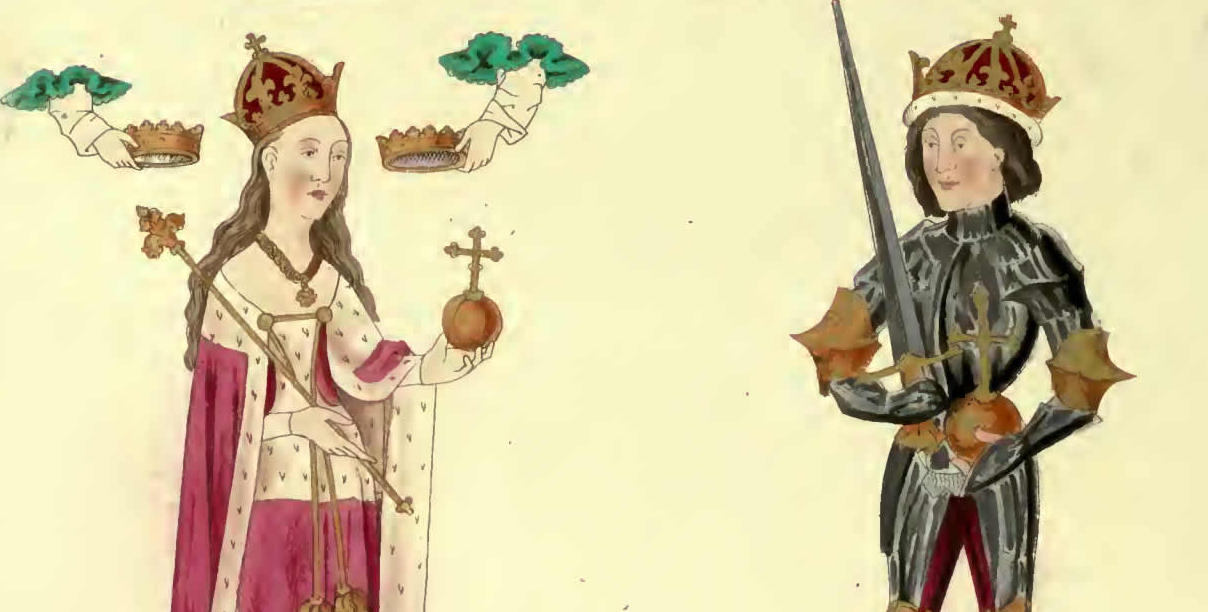To modern eyes, the coronation of a British monarch is one of spectacle. The processions through the streets of London, the gold state coach, the backdrop of Westminster Abbey, the jewels, the costumes and the music, all come together to provide something extraordinary. The coronation of Elizabeth II in 1953 was the biggest event in television history to that date, as for the first time, television cameras were allowed inside Westminster Abbey to film the ceremony itself. Over 56% of the UK population watched it. It was also broadcast in France, Holland and Germany, and the eventual worldwide audience was estimated at 227 million people. Although the audience is small by today’s standards, television ownership was then in its infancy. It seems all those with a set, tuned in.
To Medieval eyes, however, the coronation ceremony was one of the highest religious significance, with parts of it being similar to the ordination of priests. The act of anointing the monarch, with a history going back to the use of holy oils to initiate priests and rulers in the kingdoms of Israel and Judah, was viewed as a new baptism, where the king’s sins were washed away as he was filled with divine grace. Even the day chosen for a coronation had religious significance as it had to be either a Sunday or a Holy day.
Aside from the religious significance of the ceremony itself, a Medieval coronation was also an exercise in demonstrating the king’s power and wealth – propaganda in modern terms – in order to impress the Lords Temporal on whom kings during this period relied for support. The various garments worn by the king and queen and the fabrics gifted to members of the Royal Household were of the finest quality. Cloth of gold, cloth of silver as well as many different types of furs, were distributed by the Great Wardrobe. The display of gold plate at the coronation banquet, coupled with several courses made up of numerous dishes of expensive food was all designed to promote the image of the king as a person of wealth. The lengthy processions through London were also part of the display of power and influence, aimed at the local population. Holding London was an important objective during the Wars of the Roses, as demonstrated by Edward IV, who between the Second Battle of St Albans, when the Yorkist forces lost possession of Henry VI, and the Battle of Towton, just over five weeks later, made a dash to the capital to be sure of securing the backing of the City of London for his enterprise.
The coronation of English, and later, British monarchs has a long history. The first recorded description of a coronation was written sometime around 1000 AD by a monk of Ramsey who was writing a life of St Oswald, Archbishop of York. He describes how, in the year 973, King Edgar ‘convoked all the archbishops, bishops, all great abbots and religious abbesses, all dukes, prefects and judges, and all who had claim to rank and dignity from east to west and north to south over wide lands’ to assemble in Bath…. They were gathered… ‘that the most reverent bishops might bless, anoint, consecrate him, by Christ’s leave, from whom and by whom the blessed unction of highest blessing and holy religion has proceeded.’. 1 The order of service used at Edgar’s coronation was devised by St Dunstan, Archbishop of Canterbury.2
This service, celebrated with a poem in the Anglo-Saxon Chronicle, forms the basis of the present-day British coronation ceremony.
Although this is the first written description that has survived, the rites used to inaugurate a new reign had been in use for over a century before Edgar’s crowning. 3
The essential elements of the coronation have remained largely the same for 1000 years.
- Presentation to, and acclamation by, the people
- Swearing of an oath to uphold the law and the church
- Anointing
- Investiture with regalia
- Crowning
- The receiving of homage
If it is a double coronation, then the wife of the king is anointed and crowned as Queen Consort.

The documents setting out the coronation ceremony are known as ordines (from the Latin ordo, meaning order) or recensions. Two are known to survive from before the Norman Conquest. There were several changes to the ordines in the years following the arrival of William I, until the reign of Edward II in 1308, when the 4th recension was first used. One manuscript of this recension is the Liber Regalis, (Latin for “Royal Book”) which is regarded as the definitive version.4 This was used for the coronation of Richard III.
Interestingly, the document used for Richard III’s coronation specifies that the queen should wear robes of crimson, devoid of embroidery, her hair should be worn loose and held by a jewelled circlet. When she is crowned on her own, she is anointed only on the head and given a sceptre, in addition to a ring and a crown. However, in a double coronation with her husband, she is anointed also on the breast and receives in addition, a rod.5 This is the process followed for the coronation of Queen Anne.
Since the coronation of Edgar, there have been many coronations of monarchs and queens consort. As Roy Strong notes, we know very little about some of these ceremonies, but have considerable information about others. Perhaps surprisingly, the coronation of Richard III is one for which there is a significant amount of detail. There are several reasons for this. Firstly, the coronation was to be the first double coronation, since that of Edward II and Isabella of France 150 years earlier, and the first under the 4th recension. It is thought that detailed descriptions were made in order to form a template for future coronations. Secondly, Richard is likely to have taken the oath in English, unlike his predecessors who used French. A copy of the oath translated into English can be found in the Register of the Archbishop of Canterbury with Richard’s name in the final declaration, making it clear that it was for his use.6
Thirdly there were only 10 days between Richard’s formal acceptance of the crown and the coronation, which required considerable work by the Royal Household, the heralds, officers of the Great Wardrobe and others generating much in the way of orders, instructions and other written information.
During the 1980s, two researchers tasked themselves with tracking down all the surviving documents that related to Richard’s coronation. Their work culminated in the publication of a book, now sadly out of print – The Coronation of Richard III: the Extant Documents, edited by Anne F Sutton and P W Hammond. The book not only reproduces the texts of the documents, with an authors’ commentary on each, but includes a chronology of events leading up to the coronation, an informative glossary of Medieval terms used in the documents as well as short biographies of people involved with preparations for, or taking part in, Richard’s coronation.
For the days immediately prior to his coronation, Richard followed the practices laid down since 1399 (when creating new Knights of the Bath was added to the ceremonies surrounding a coronation) with one addition introduced by Edward IV.

Events associated with the conflict between the House of Lancaster and the House of York, had disrupted the usual process of presenting a new king to the people at his coronation. In 1461, Edward IV needed to ascend the throne immediately as a result of popular acclamation. Warwick had lost the Second Battle of St Albans on 17th February as well as losing control over the person of Henry VI. Edward needed to consolidate his power quickly in London before dealing with the Lancastrian forces. He could not wait for a coronation. On 4th March, after a Te Deum at St Paul’s, Edward rode to Westminster, put on royal parliamentary robes and a cap of maintenance (not a crown) and then took possession of the marble King’s Bench.
On 26th June, 1483, following presentation of a petition (setting out his title to the throne) by the lords, spiritual and temporal, and commoners, Richard was conducted to Westminster in procession. Like his brother before him, he put on royal robes and carried a sceptre. He took possession of the royal estate by the act of enthronement in the marble chair of the King’s Bench and dated his reign from this date.7 This was a secular enthronement. Unlike Richard’s, Edward’s coronation did not take place for three months, after the Battle of Towton, which confirmed his decisive defeat of the Lancastrians. Richard on the other hand, designated 6th July as the date for his coronation, a mere ten days later.
On 4th July, Richard and his queen moved from Baynard’s Castle to the Tower of London. It is not known if they travelled by water. Later that morning, dinner was held at the Tower where esquires, candidates for the accolade of Knights of the Bath, served the King.8
On 5th July (The Vigil or Eve of the Coronation) the king and queen heard mass, then Richard conferred the accolade on the prospective Knights of the Bath who had spent the previous night in prayer. Dinner followed, where the newly created knights served the king.
During the afternoon, there was a long procession which conducted the king and queen from the Tower to Westminster. During the journey, there were pauses to listen to singing and speeches at various points.
After a ‘souper’ in the great chamber of the Palace, the king took his ceremonial bath to cleanse himself before his anointing.
On 6th July, Richard was bathed and clothed in the special garments needed for his anointing. The queen was also dressed by her ladies for the ceremony. A discussion of the clothing and fabrics used will be the subject of a subsequent article.
The king and queen went to Westminster Hall, to await the ecclesiastical procession which they then joined. Behind this, came the secular procession, with various nobles carrying parts of the regalia. 9
The right to carry items from the regalia or to perform services of honour during the ceremony was a jealously guarded privilege. In the 13th century there had been disputes over who had the right to do what, which complicated the organisation of coronations. To overcome these problems, a Court of Claims was established before each coronation to sort out and pronounce on bids by rival contenders. 10
Normally there was plenty of time to consider each case, but Richard’s Court of Claims met only three days before the coronation, due to the short time frame between his formal acceptance of the crown and his coronation.
By the time of Richard’s coronation, the regalia was a collection of objects and clothing which symbolised the status of the monarch. The regalia of the king numbered fourteen items, and that of the queen consort, four items. There were also items which were borne in the coronation procession but played no part in the coronation itself. These were three Swords of Justice, St Edward’s Staff and the Constable’s mace. 11
The most important item in the regalia was the crown itself, known since 1220 as St Edward’s Crown. There were differing origins put forward for this particular crown with some believing it had been found in the grave of Edward the Confessor when he was translated to a new tomb in Westminster Abbey. Lord Twining, who wrote extensively on European regalia, devoted several pages to the origins of the English coronation crown. He noted that the Confessor’s first seal and 6th type of coinage showed an open circlet surmounted by four lily-like ornaments. Both Edward and Harold are shown wearing this in the Bayeux Tapestry. But in 1052, Edward ordered an Imperial Crown and his 8th type of coinage shows him wearing it.
There is pictorial evidence that the English coronation crown used at least from the beginning of the 14th century, and called St Edward’s Crown, was arched and Twining concluded that it was the so-called Imperial Crown ordered in 1052, and which had been carefully preserved in Westminster Abbey, rather than any crown discovered in Edward’s grave. 12

The regalia, apart from the 12th century Coronation Spoon, was destroyed by Cromwell in the 17th century. On the Restoration of Charles II in 1661, a new regalia was ordered which is still in use today.
The procession entered the Abbey by the West door and the order of service laid down in the Liber Regalis was followed. After the crowning, Mass was sung, again following the requirements of the Liber Regalis. After the mass, the crowns were taken from the royal couple and returned to the altar before the shrine of Edward the Confessor
Both the king and queen had fasted up to this point, so they were taken to an area prepared for them where they could eat if they wished. After this, there was another change of clothing, then another procession was formed and all returned to Westminster Hall.13
The king and queen retired to their chambers for a rest while arrangements were made for the Coronation Banquet, the final ceremony of coronation day. At 4pm, the king and queen returned to take their places at the banquet which lasted for several hours. Using information from the documents, including the fact that 3,000 wooden cups had been ordered for the banquet, Sutton and Hammond concluded that an estimated 3,000 people were fed during the banquet. The surviving documents show that Richard’s banquet had three courses of sixteen, sixteen and seventeen dishes but two years later, the coronation banquet of Henry VII only had two courses with a total of forty dishes. Sutton and Hammond speculate that this was as a result of the length of Richard’s banquet which had to break up with the third course unserved. 14
The ceremonies around Richard’s coronation closed with the banquet. There is no record of the days following being used for days of estate or for jousting, which had followed earlier coronations.
From the information in the documents tracked down by Sutton and Hammond, there can be no doubt that Richard’s coronation fulfilled the purpose of showing him to be a king of wealth and power. However, not all the lords temporal appeared to give him their full support as a mere three months after his coronation, Richard found himself facing a rebellion headed by the Duke of Buckingham.
- Strong, Roy Coronation: A History of Kingship and the British Monarchy, HarperCollins, 2005 p 3 ↩
- Gosling, Lucina Royal Coronations Shire Publications Ltd pp 5-7 ↩
- Strong; Op cit p 8 ↩
- Ibid p 84 ↩
- Ibid pp 89-90 ↩
- Sutton, Anne F. & Hammond, P.W. The Coronation of Richard III – the Extant Documents Alan Sutton, Gloucester, 1983 p 3 ↩
- Ibid p 25 ↩
- Ibid p 28 ↩
- Ibid pp 35-39 ↩
- Strong Op cit p 102 ↩
- Sutton & Hammond Op cit p 229 ↩
- Twining, Edward Francis (Lord) European Regalia T Batsford Ltd, 1967 pp 103-106 ↩
- Sutton & Hammond Op cit pp 42-43 ↩
- Ibid pp 285-286 ↩

